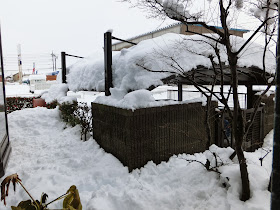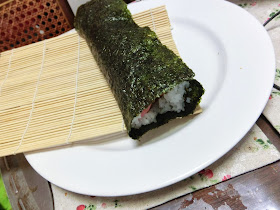I started to make a handmade picture book.
I posted about this topic on my face book page.
As you know, Japan is the Kingdom of comic book.
I used to write some cartoons with my friends when I was kid.
Young children like comic books in Japan.
I don't know how much there are children who spent their childhood on
writing cartoons.
I started this blog to introduce Japanese cultures in English. I am Japanese man. The purpose of this blog is to show various Japanese cultures you can't read on guide book, TV or the other media. I want to introduce Japanese foods, natures, lifestyle, good place for sight seeing, and so on. More than 75 countries' people all over the world have checked this blog! Thank you so much! Moreover, I sometimes show a short story I have written on this blog. www.facebook.com/SeeMyJapan
Friday, February 28, 2014
Tuesday, February 25, 2014
Japanese traditional culture ~48~ The moon
Traditionally, we sometimes say, you can see two rabbits on the moon.
The pattern we can see on the moon in Japan is decribed: two rabbits
are making a "mochi".Those rabbits are pounding steamed rice used for rice cakes.
I've heard there is the similar story in the other countries.
It may depends on the pattern which people can see on the moon.
How do you descibe in your culture?
The pattern we can see on the moon in Japan is decribed: two rabbits
are making a "mochi".Those rabbits are pounding steamed rice used for rice cakes.
I've heard there is the similar story in the other countries.
It may depends on the pattern which people can see on the moon.
How do you descibe in your culture?
Sunday, February 23, 2014
Japanese lifestyle ~75~superstition
Today, I went to the tomb of my family.
I've got an idea to introduce a superstition on this blog.
In my area, there is a superstition.
"You should not go back to your home on the
same route as the one you went to the tomb."
It is inauspicious thing.
I don't know whether there is the same kind of superstition
in all Japan. My wife is from the city 70 km far from my hometown.
But I heard there is such a superstition in her hometown.
I've got an idea to introduce a superstition on this blog.
In my area, there is a superstition.
"You should not go back to your home on the
same route as the one you went to the tomb."
It is inauspicious thing.
I don't know whether there is the same kind of superstition
in all Japan. My wife is from the city 70 km far from my hometown.
But I heard there is such a superstition in her hometown.
Saturday, February 15, 2014
Japanese lifestyle ~74~ Tons of snow...
We have had tons of snow since yesterday.
This has been the greatest amount of snow
since the Meteorological Agency started to research.
People have to get snow out of the way.
I took the picture at the entrance of my house. The snow on the roof fell
down the ground. And a lot of snow were piled...
This has been the greatest amount of snow
since the Meteorological Agency started to research.
People have to get snow out of the way.
I took the picture at the entrance of my house. The snow on the roof fell
down the ground. And a lot of snow were piled...
Thursday, February 13, 2014
Japanese traditional culture ~47~ Hina dolls
I show you these Hina dolls. These dolls are more luxurious than the last one I showed
on this blog.
Each figure is big.
My wife's parents bought these Hina dolls for her.
Look at the fourth picture. The clothing is folded inside. This style is called
"Kimekomi". This technique requires a lot of exertions.
on this blog.
Each figure is big.
My wife's parents bought these Hina dolls for her.
Look at the fourth picture. The clothing is folded inside. This style is called
"Kimekomi". This technique requires a lot of exertions.
Monday, February 10, 2014
Japanese food ~38~~Miso~ Do you know how to make it?
Yesterday, I had an unusual experience.
I joined a kind of workshop to make miso.
First of all, do you know the miso? Miso is a Japanese traditional food
which is put in the miso soup.
We usually get it at a super market. It looks like this.
Miso is made from soy beans. I've already known that. I guess most of
Japanese know about that. We learn such a thing in our childhood.
There are so many beans in the bucket. These beans were steamed for four hours.
We bought 5 kg miso yesterday.
And then you mix the smashed soy beans with malted rice.
After you mix it, you make some balls.
You put these balls in the bucket. You need to level it.
The reason why you make balls is that the air would not be contained in the
miso. There are many miscellaneous germs in the air.
Almost it's done. After you put on the cover, you put weight on the cover.
You have to preserve it for a half year in your house.
My wife's family lent me hina dolls set. There are dolls in my house already.
But these hina dolls are bigger than that I have showed on this blog.
I will show this type of doll in the near future. Look forward to it!!
I joined a kind of workshop to make miso.
First of all, do you know the miso? Miso is a Japanese traditional food
which is put in the miso soup.
We usually get it at a super market. It looks like this.
Miso is made from soy beans. I've already known that. I guess most of
Japanese know about that. We learn such a thing in our childhood.
There are so many beans in the bucket. These beans were steamed for four hours.
We bought 5 kg miso yesterday.
And then you mix the smashed soy beans with malted rice.
After you mix it, you make some balls.
You put these balls in the bucket. You need to level it.
The reason why you make balls is that the air would not be contained in the
miso. There are many miscellaneous germs in the air.
Almost it's done. After you put on the cover, you put weight on the cover.
You have to preserve it for a half year in your house.
My wife's family lent me hina dolls set. There are dolls in my house already.
But these hina dolls are bigger than that I have showed on this blog.
I will show this type of doll in the near future. Look forward to it!!
Thursday, February 6, 2014
Japanese lifestyle ~73~ Ehoumaki and Setsubun
February 3 was "Setsubun 節分".
In Japan, we have a special tradition on that day.
Have you ever heard of "Oni"? That's like a demon character in Japan.
It is like a witch in Europe, maybe. (I'm not exactly sure what kind of image
people have in the witch.)
In Japanese culture, Oni is described as a demon that eats human, and
does bad things, such as damaging the crops.
In Setsubun, a man disguises himself as the Oni, wearing a mask of Oni.
People throw beans(豆) to the person, crying out "Oni is outside!!".
The oni runs away and goes outside of the house.
After you drive out the Oni, you can eat as many beans as your age.
And also, there are other customs on that day.
You decorate a branch of a holly at your entrance door like below.
The stuffs at the top of the branch are heads of sardines.
This stuff has the meaning of protecting people from evil.
You eat Ehoumaki(恵方巻き) on this day. Ehoumaki is just like a sushi.
There is a strange custom on eating Ehoumaki.
You have to eat this Ehoumaki in the certain direction.
I mean, you had to eat Ehoumaki, facing in the direction of east-northeast in this year.
The direction you had to face depends of the year.
I guess this custom has been made by the sushi industry as a campaign.
In Japan, we have a special tradition on that day.
Have you ever heard of "Oni"? That's like a demon character in Japan.
It is like a witch in Europe, maybe. (I'm not exactly sure what kind of image
people have in the witch.)
In Japanese culture, Oni is described as a demon that eats human, and
does bad things, such as damaging the crops.
In Setsubun, a man disguises himself as the Oni, wearing a mask of Oni.
People throw beans(豆) to the person, crying out "Oni is outside!!".
The oni runs away and goes outside of the house.
After you drive out the Oni, you can eat as many beans as your age.
And also, there are other customs on that day.
You decorate a branch of a holly at your entrance door like below.
The stuffs at the top of the branch are heads of sardines.
This stuff has the meaning of protecting people from evil.
You eat Ehoumaki(恵方巻き) on this day. Ehoumaki is just like a sushi.
There is a strange custom on eating Ehoumaki.
You have to eat this Ehoumaki in the certain direction.
I mean, you had to eat Ehoumaki, facing in the direction of east-northeast in this year.
The direction you had to face depends of the year.
I guess this custom has been made by the sushi industry as a campaign.
Sunday, February 2, 2014
Japanese traditional culture ~46~Hina dolls
We decorated Hina dolls at the entrance in my house.
These dolls are decorated around March 3.
They are wearing the clothes of Heian period.(more than one thousand years old)
The central figure of male is called "Odairi sama".
And the other side, the figure of female is called "Ohina sama"
Each doll should be put on the right position.
(Actually, I learned that the old man should be put on the right side.
I noticed that after taking these pictures.)
I can image the clothes of nobles in Heian period easily.
I guess it is because we see these Hina dolls in our childhood.
Maybe these dolls would look unusual for your eyes.
I heard my family decorated these dolls when I was a child.
I don't remember at all. We decided to decorate Hina dolls
because I started this blog. We did that to introduce our traditional culture!
These dolls are decorated around March 3.
They are wearing the clothes of Heian period.(more than one thousand years old)
The central figure of male is called "Odairi sama".
And the other side, the figure of female is called "Ohina sama"
Each doll should be put on the right position.
(Actually, I learned that the old man should be put on the right side.
I noticed that after taking these pictures.)
I can image the clothes of nobles in Heian period easily.
I guess it is because we see these Hina dolls in our childhood.
Maybe these dolls would look unusual for your eyes.
I heard my family decorated these dolls when I was a child.
I don't remember at all. We decided to decorate Hina dolls
because I started this blog. We did that to introduce our traditional culture!



























